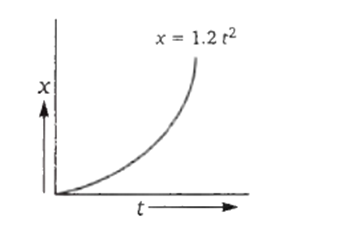 Multiple Choice Questions
Multiple Choice QuestionsA rocket of mass 100 kg burns 0.1 kg of fuel per sec. If velocity of exhaust gas is 1 km/sec, then it lifts with an acceleration of
1000 ms-2
100 ms-2
10 ms-2
1 ms-2
D.
1 ms-2
Given that, = 0.1 kg/s ; mass of the rocket = 100 kg and v = 1 km/s = 1000 m/s
Thrust on the rocket, F =
= 1000 × 0.1
Now, F = Ma
∴ a =
= 1 m/s2
A bullet emerge from a barrel of length 1.2 m with a speed of 640 ms-1 . Assuming constant acceleration, the approximate time that it spends in the barrel after the gun is fired is
4 ms
40 ms
400 μs
1 s
The acceleration a (in ms-2 ) of a body, starting from rest varies with time t (in s) following the equation a = 3 t + 4. The velocity of the body at time t = 2 s will be
10 ms-1
18 ms-1
14 ms-1
26 ms-1
Figure below shows the distance-time graph of the motion of a car. It follows from the graph that the car is

at rest
in uniform motion
in non-uniform acceleration
uniformly accelerated
 Short Answer Type
Short Answer TypeA shell of mass m is at rest initially. It explodes into three fragments having masses in the ratio 2 : 2 : 1. The fragments having equal masses fly off along mutually perpendicular direction with speed v. What will be the speed of the third (lighter) fragment ?
 Multiple Choice Questions
Multiple Choice QuestionsIf a person can throw a stone to maximum height of h metre vertically, then the maximum distance through which it can be thrown horizontally by the same person is
h
2h
3h
A box is moved along a straight line by a machine delivering constant power. The distance moved by the body in time t is proportional to
t1/2
t3/4
t3/2
t2
A particle is moving with a constant speed v in a circle. What is the magnitude of average velocity after half rotation ?
2v
A box of mass 2 kg is placed on the roof of a car. The box would remain stationary until the car attains a maximum acceleration. Coefficient of static friction between the box and the roof of the car is 0.2 and g = 10 ms-2. This maximum acceleration of the car, for the box to remain stationary, is
8 ms-2
6 ms-2
4 ms-2
2 ms-2
A particle is travelling along a straight line OX. The distance x (in metre) of the particle from O at a time t is given by x = 37 + 27t − t3, where t is time in seconds. The distance of the particle from O when it comes to rest is
81 m
91 m
101 m
111 m
